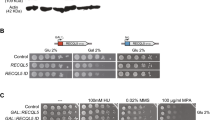Abstract
The bud emergence (BEM) 46 proteins are evolutionarily conserved members of the α/β-hydrolase super family. The exact function(s) of these proteins remains unknown. Vegetative hyphae, perithecia and ascospores of Neurospora crassa RNAi and over-expressing transformants develop normally, but hyphal germination from ascospores is impaired. The protein is localized in the perinuclear endoplasmatic reticulum and also forms spots near to the plasma membrane. One human paralog appears to be responsible for a genetic disorder.
Similar content being viewed by others
Literatur
Bork P (2000) Powers and pitfalls in sequence analysis: the 70 % hurdle. Genome Res 10:398–400
Galperin YM, Koonin VE (2010) From complete genome sequence to ‘complete’ understanding? Trends Biotechnol 28:398–406
Fiskerstrand T, H’mida-Ben Brahim D, Johansson S et al. (2010) Mutations in ABHD12 cause the neurodegenerative disease PHARC: an inborn error of endocannabinoid metabolism. Am J Hum Genet 87:410–417
Ollis DL, Cheah E, Cygler M et al. (1992) The α/β hydrolase fold. Protein Eng 5:197–211
Holmquist M (2000) Alpha beta-hydrolase fold enzymes structures, functions and mechanisms. Curr Protein Pept Sci 1:209–235
Mochizuki S, Harada A, Inada S et al. (2005) The Arabidopsis WAVY GROWTH 2 protein modulates root bending in response to environmental stimuli. Plant Cell 17:537–547
Mercker M, Kollath-Leiss K, Allgaier S et al. (2009) The BEM46-like protein appears to be essential for hyphal development upon ascospore germination in Neurospora crassa and is targeted to the endoplasmic reticulum. Curr Genet 55:151–161
Berepiki A, Lichius A, Shoji JY et al. (2010) F-actin dynamics in Neurospora crassa. Eukaryot Cell 9:547–557
Author information
Authors and Affiliations
Corresponding author
Additional information
Krisztina Kolláth-Leiß 1999–2002 Studium der Biologie, Eötvös Loránd Universität, Budapest, Ungarn. 2003–2008 Studium der Biologie an der Universität zu Kiel. Seit 2008 Dissertation bei Prof. Dr. F. Kempken.
Frank Kempken 1980–1985 Studium der Biologie an der Universität Bochum, 1988 Promotion bei Prof. Dr. Dr. h. c. mult. K. Esser, 1989–1990 Postdoc bei Prof. Dr. D. Pring, University of Florida, USA.1996 Habilitation, 1996–2001 Hochschuldozent an der Universität Bochum. Seit 2001 Professur für Botanische Genetik und Molekularbiologie an der Universität zu Kiel, seit 2011 Vizepräsident der Gesellschaft für Genetik.
Rights and permissions
About this article
Cite this article
Kolláth-Leiβ, K., Kempken, F. Bem46-Homologe: bekannte Proteine mit unbekannter Funktion. Biospektrum 18, 251–253 (2012). https://doi.org/10.1007/s12268-012-0170-3
Published:
Issue Date:
DOI: https://doi.org/10.1007/s12268-012-0170-3




